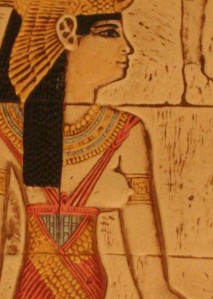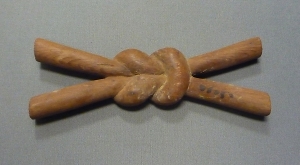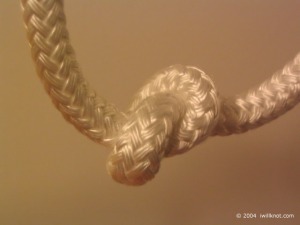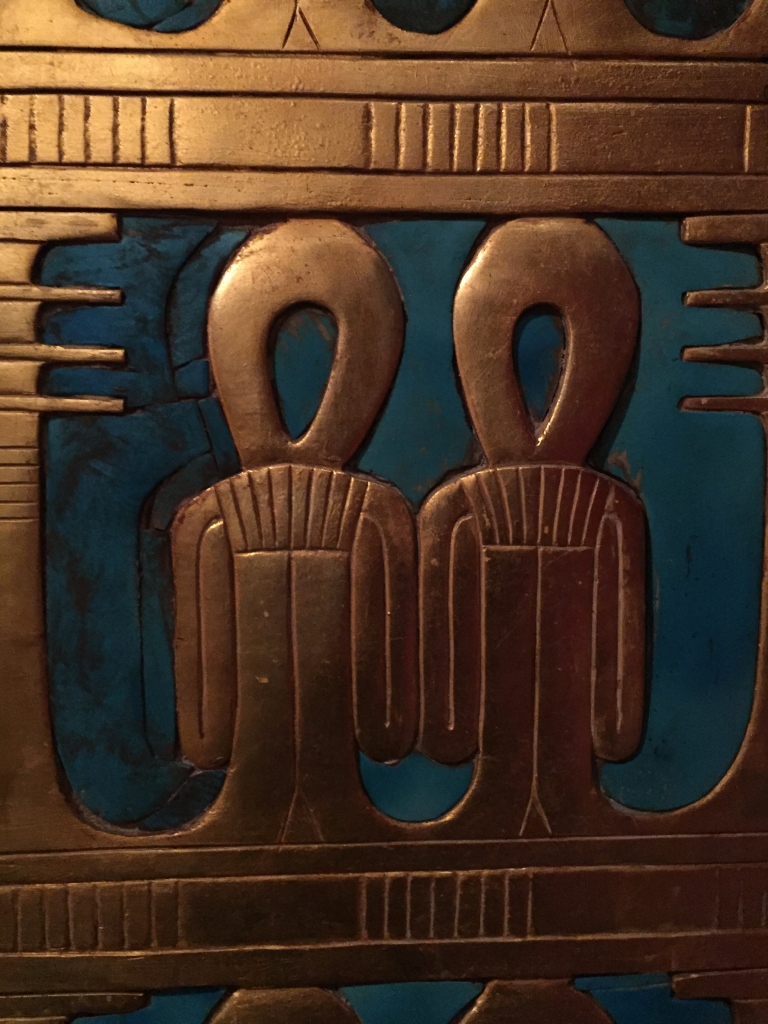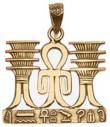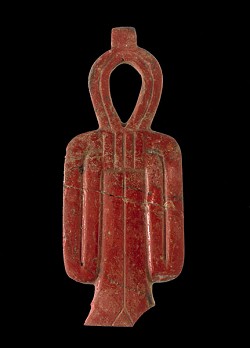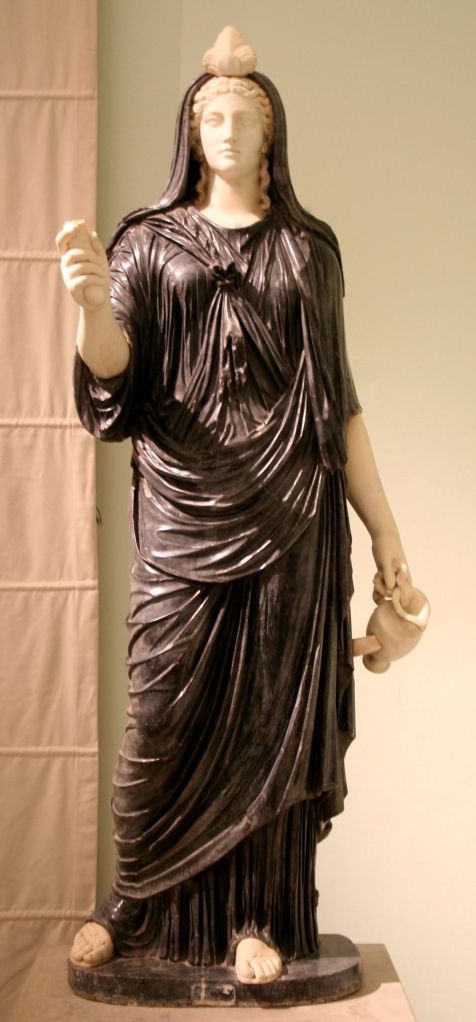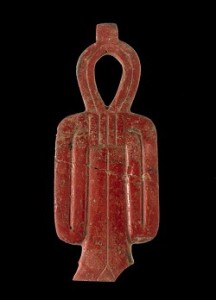I think I mentioned that Isis took, as an offering from me, a silver Knot of Isis when I visited Her Philae temple earlier this year. I had it on a chain around my neck when we took the boat over to the temple…and it was simply gone when we came back. It made me smile.

Knots are important symbols for Isis and of Her. Most of us are very familiar with the Knot of Isis, the knot amulet that resembles an ankh, but with the “arms” folded down. Learn more about it here. But there’s another reason Isis is connected with knots. And that’s because She is the Goddess of Magic—heka, in Egyptian—and very often, heka was and still is worked by the tying of knots.
Ancient Egyptian texts often describe working heka as weaving or knitting, which is just another form of knotting. The deceased person is said to be “knit together in the egg” prior to rebirth. Some texts say that the head of the deceased is “knit on.” The concept of weaving, knitting, or knotting magic—bringing the strands of magic together to create or preserve or repel—makes complete and utter sense to me. There is a delicacy and precision that the many types of knotting require that speaks to me as a very viable way to work magic.

The basic idea is simple enough: tied knots bind and untied knots release. Beyond that, knots can unite opposites and—since a knot secures things—protect.
Knot magic was well known in Egypt from an early period; an inscription in one of the pyramids says that Isis and Nephthys work magic for Osiris “with knotted cords.”
The Book of Coming Forth by Day (aka Book of the Dead) also gives several examples of the magical power of the knot. In one, knots are tied around the deceased to help them come into the presence of the Deities: “The four knots are tied about me by the guardian of the sky [. . .] the knot was tied about me by Nuet, when I first saw Ma’et, when the gods and the sacred images had not yet been born. I am heaven born, I am in the presence of the Great Gods.”

In addition to these four knots, another text talks about seven knots, or tesut, that were tied about the deceased to protect them.
The power of the magical knot is in its ability to both unite and “surround” things. The tied knot is a symbol of the coming together of two things in perfect wholeness, a condition that promotes a positive outcome.
A passage in the Coffin Texts says that when the hair of Isis is knotted to the hair of Nephthys, the Two River Banks (that is, the land of the living and the land of the dead) are united. Tying a knot could also refer to sexuality; the perfect coming together of two people in an act of creation. We still “tie the knot” when we get married.
Furthermore, because the two ends of the cord used in tying a magical knot symbolically go all the way around something, they “surround” that thing. Thus knot magic could be used to surround” or bind an enemy—or even tie a curse to them.
In Spell 42 in Budge’s translation of the Book of the Dead, the knot appears as a kind of seed. The deceased is said to be “the knot within the tamarisk tree, beautiful of splendor more than yesterday.” This surely refers to Osiris within the tree prior to His resurrection.
And, of course, as you already know, the famous Knot of Isis is a very magical knot. In most cases, it is protective and associated with renewal and resurrection. As time passed, it became a must-have amulet for all mummies and was usually placed on the upper torso.
If you’d like to work some protective knot magic for yourself, here’s a ritual, slightly adapted, from my Isis Magic (new edition coming in spring of 2026 from REDFeather Publishing!! Yay!) that you can use to do so.
In this rite, we are using the knots to surround with protection. We call upon Isis primarily, but also Nephthys, Neith, and Selket as the four Goddesses often found guarding the four corners of a shrine as well as the four Sons of Horus, Who in turn protect the canopic jars.
The Rite of the Tiet (the Knot of Isis)
About the Rite: In this ritual, you will magically tie a protective knot around yourself, or around anything or anyone you wish to protect. The ritual draws upon sources in the Book of Coming Forth by Day and is, in part, adapted from an ancient rite for consecrating the Tiet amulet.
Temple Arrangement: Altar at center; all tools on altar.
Ritual Tools: Nile water in Lotus Cup; flower petals from lotus, lily, or rose; Isis incense in censer; six pieces of fairly substantial red cord, each approximately one foot long (if you can’t find red cord that is thick enough, use white rope).
Opening
Purify and consecrate the temple and yourself according to the formulae of the House of Isis or any method you prefer. Return to the altar, take up the lotus (lily or rose) petals and elevate them.
Ritualist: O, you Souls of Life, Lotus Dwellers, Breathers, you of the Pure Air from the Wings of Isis, I have come for you. By the Blood, by the Power, by the Magic of Isis, establish yourselves within these petals. (Vibrating onto petals) ISET NEF!
Place some of the petals in the chalice.
Ritualist: (Addressing petals) I know you, you shining flowers. Your name is “Life Is In It”. Your name is “Protection”. Your name is “Peace Bringer”.
Place the pieces of cord upon the altar and anoint each of them with the Nile water with flower petals in it.
Ritualist: (Touching each piece of cord) Isis protects!
Invocation of the Powers of Isis
Next, invoke the Goddess, raising your arms in Adoration.
Ritualist: I call the power of my Mighty Mother Isis. I call Her strength to me. I call upon the Power and the Peace of Isis, for I shall knot the cord, the Knot of Isis.
O Isis, my Mother, I call You!
I call You with the breath of my body (breathing out).
I call You with the beat of my heart (touching your chest).
I call You with the pulse of my life (touching your wrists).
I call You with the words of my mouth (touching your mouth).
I call You with the thoughts of my mind (touching your forehead).
I call You Power. I call You Life. I call You Protection.
I call You, Isis!
Tying the Knots
Take up one of the pieces of red cord and move to the southeast corner of your ritual space. Holding the two ends of the cord in your hands, say:
Ritualist: You have Your Blood, O Isis. You have Your Power, O Isis. You have Your Magic, O Isis. The Blood of Isis and the Strength of Isis and the Words of Power of Isis shall be mighty to (state what you wish to protect) against all that would cause harm.
With strength and intention, tie a knot in the cord and set it in the southeast corner of the ritual space.
Ritualist: By the Power of Isis, I have knotted the cord.
Repeat this same procedure in the southwest, northwest, and northeast of the temple, above your head (leaving the cord on top of the altar), and upon the ground (leave the cord at the foot of the altar).
Stand west of the altar, facing east. Make the Sign of the Wings of Isis (raise and open your arms like wings).
Ritualist: O Isis and all You mighty Goddesses of Protection, I call upon You to guard (state what you wish to protect) as You did guard Osiris Himself, as You did guard Horus the Child.
Isis, Mighty Magician; Nephthys, Lady of Life; Neith, Primal Mother; Selket, Powerful One—tie the Knot of Isis against all harm. Keep it away! Restrain it! Let it not come near! O, Isis and all You Goddesses of Protection, grant Your peace and protection.
If you wish to meditate or do other work, this is an excellent time to do so.
Closing
If this is a ritual for protection from some outside threat, leave the tied knots in your ritual space for as long as desired or needed and conclude the rite by making the Sign of the Wings of Isis at the altar and speaking the last line.
If this rite is worked simply to create peace for meditation, you may untie the knots when you are finished by simply going to each knot in the order you tied it and untying it, then returning each one to the altar.
Ritualist: I have untied the knot. Be in peace, O You Blood and Power and Magic of Isis. Be in peace.
At the altar, make Sign of the Wings of Isis.
Ritualist: I thank You, Isis, in all Thy names of Protection. Hold me ever near You, bound by Your protective knots.
The rite is complete.















